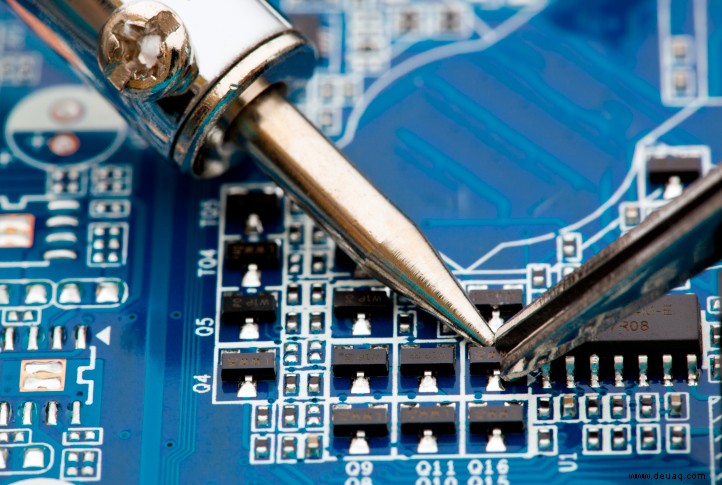
Wenn Ihr Computer plötzlich (oder nicht so plötzlich) nicht mehr funktioniert, liegt das Problem möglicherweise am Motherboard. Leider sind sie auch eine der problematischsten Computerkomponenten, die repariert oder ersetzt werden müssen. Das Motherboard ist nicht nur normalerweise eine der teureren Komponenten auf dem Computer, wenn Sie es ersetzen müssen, müssen Sie oft auch die CPU und den Speicher ersetzen – eine Ausgabe, die bedeuten kann, dass ein ganz neuer Computer tatsächlich eine billigere Alternative wäre.
Bevor Sie jedoch die Kreditkarten ausgraben, sollten Sie einige Dinge überprüfen, da das scheinbar tote Board tatsächlich in Ordnung sein kann. In diesem Artikel zeige ich Ihnen, wie Sie Motherboard-Probleme diagnostizieren und einige Alternativen zum Ersetzen eines defekten Boards.
Was ist ein Motherboard?
Für Leute, die nicht mit dem Bau von Computern aufgewachsen sind und die Architektur dieser allgegenwärtigen Maschinen nicht gelernt haben, lassen Sie uns ein kurzes Tutorial über die Komponenten eines Personal Computers geben und darüber, wo das Motherboard in das Schema passt. Sowohl konzeptionell als auch physisch haben Computer drei grundlegende Arten von Komponenten:den Prozessor, den Speicher (Speicher und auch permanenten Speicher) und das Ein-/Ausgabesystem (E/A).
Der Prozessor ist Ihre CPU, wahrscheinlich ein Mikrochip von AMD oder Intel, zusammen mit Ihrer GPU, falls Sie eine haben. Der Speicher ist Ihr RAM und Ihre Festplatte(n) – wo Sie Ihre Informationen ablegen. Schließlich umfasst das Eingabe-/Ausgabesystem alle Elemente, die Ihnen die Interaktion mit dem Computer ermöglichen – die Grafikkarte und der Monitor, die Tastatur, die Maus usw.
Wo passt also das Motherboard in dieses System? Nun, das Motherboard ist nicht konzeptionell wichtig, aber es ist physikalisch entscheidend. Es ist die Leiterplatte (eigentlich ein Satz von Leiterplatten, die alle zusammengefügt sind), auf der all diese anderen Komponenten platziert sind. Die CPU wird an das Motherboard angeschlossen, wo sie über einen als „Bus“ bezeichneten Kanal mit der Festplatte, dem Speicher, der Tastatur und allem anderen kommuniziert.
Der Speicher wird im Allgemeinen direkt auf dem Motherboard platziert; Die Festplatte befindet sich wahrscheinlich in einem eigenen Bereich, aber sie ist mit einem Festplattencontroller verbunden, der sich, Sie haben es erraten, auf dem Motherboard befindet. Die Tastatur und die USB-Steckplätze sind direkt mit dem Motherboard verbunden. Die Grafikkarte wird normalerweise mit einem eigenen Bus an das Motherboard angeschlossen.
Es wird „Motherboard“ genannt, weil es wie ein Mutterschiff die Basis ist, auf der Ihr gesamter Computer arbeitet. Kein Motherboard, kein PC.
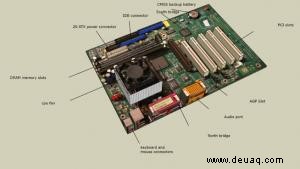
Frühwarnzeichen
Wenn Ihr Computer beginnt, Probleme zu entwickeln, gibt es einige Frühwarnzeichen, dass ein Teil (meistens) schlecht wird. Hier sind einige Dinge, auf die Sie bei Ihrem Motherboard achten sollten:
- Motherboard doesn’t recognize/show peripherals.
- Peripherals will stop working for a few seconds or more.
- Slow boot-ups could indicate that your motherboard is going bad, though it could be other components as well (more on this below).
- Computer won’t recognize flash drives, or monitor sometimes shows strange lines (particularly relevant if you have onboard video on your motherboard).
- Motherboard doesn’t POST (Power On Self Test).
- Burning smell or burn marks anywhere on the motherboard itself.
- Bulging or leaking capacitors
Signs of Failure
Motherboards are historically the most difficult pieces of hardware to diagnose because, in most cases, you have to rule out every other piece of hardware that is connected to it. There aren’t usually any real signs of failure, other than your computer suddenly turning into an expensive doorstop.
A hard drive might give you signs of failure, such as blue screens or lost files, but a motherboard will just suddenly stop working. That being said, here are some things you can try first to ensure the problem is with your motherboard instead of another hardware component.
Diagnosing the Problem
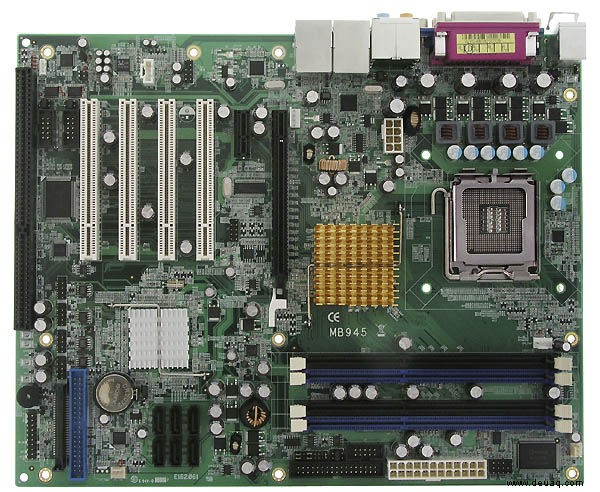
There are some easy troubleshooting steps you can take to determine if your motherboard is going bad. Below we break the troubleshooting procedure into two categories:1) What to check if the computer still passes the POST and boots (or attempts to boot), and 2) what to check if the computer no longer passes the POST or does not even turn on.
Computer Passes POST and Boots OS
If your computer still turns on and even boots into the operating system, you should rule out other hardware components first to make sure these aren’t causing the symptoms listed above.
Hard drive(s): Are files taking a long time to transfer? Are you seeing errors or blue screens? Has boot-time increased significantly? Do you hear any clicking or loud whining noises? If the answer to any of these questions is yes, your hard drive may be going bad. It will be worthwhile to run the diagnostic utilities in Windows and/or from the drive’s manufacturer. Also, see our companion article on Hard Drive Failure:Warnings and Solutions.
Video: Does the display seem garbled or do you see artifacts on the screen that you did not see before? Do graphics-intensive tasks cause blue screens or instability? If so, your video card may be going bad and will warrant further testing. Also, see our guide on video card failure symptoms for further troubleshooting.
Memory (RAM): Even though it doesn’t have any moving parts, there is a chance that your memory could be failing and causing your system to error or become unstable. In this case, a running a diagnostic tool such as Memtest86 or Memtest86+ is recommended for further troubleshooting.
Processor (CPU): Although somewhat rare, CPU failure could be a cause of system instability. If you have an Intel processor, downloading and running the Intel Processor Diagnostic Tool may uncover issues with the processor itself. For AMD processors, try the AMD system monitor tool.
Power Supply (PSU): A failing or insufficient power supply (or one that is operating out of spec) can quickly cause a system to become unstable and also potentially cause damage to the other computer system components. Ensure you have the proper power supply for your system and double-check the supply’s voltages to make sure they are operating in line with their rated output (the voltages can easily be monitored in the BIOS or in software utilities supplied by motherboard manufacturers). If you are still unsure, please also read through our article on power supply troubleshooting.
Motherboard BIOS Updates: Many system instabilities can be fixed by a motherboard BIOS update (especially on newer hardware). Please consult the support site of your motherboard’s manufacturer for more details.
Finally, also a brief word on system cooling:In many instances, errors are experienced due to improper cooling or even cooling failure in a computer system. If any of the system’s components are operating out of spec due to overheating, system instability can result.
A visual inspection of the system is suggested to make sure that all components are seated properly and being cooled sufficiently (i.e. case and component fans are operating normally). Temps can also be monitored for anomalies inside the operating system using a wide variety of tools – we suggest a few free ones you can use in our article on PC temperature monitoring.
Computer Does Not POST or Turn On
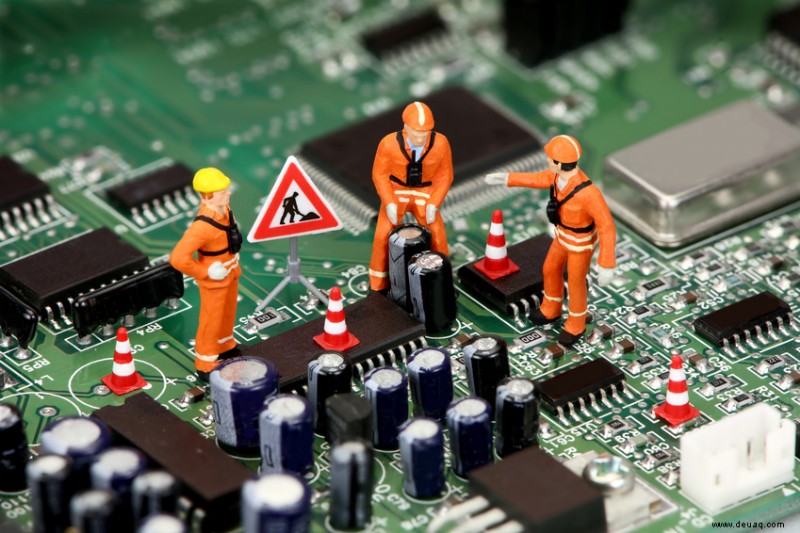
If your computer doesn’t pass the POST test or even turn on, hardware failure is almost certain. But the motherboard might still be functional. We want to make certain it’s not some other culprit.
The first to thing to do is perform a brief visual inspection on the system itself. Are all components seated properly? If the system turns on, are all the fans spinning? If the motherboard has a visual LED indicator, what color is it (usually green means everything is OK)? If there is any doubt, try re-seating components as necessary and try starting the system again.
Some modern motherboards will even have LEDs for individual components. For instance, if there’s a problem with your RAM or CPU, you should be able to find an LED near that specific component, indicating if there’s a problem or not (again, green usually means everything is OK).
The second thing to do is confirm whether the motherboard produces error (or beep) codes when trying to start the system up with key components missing (e.g. CPU, RAM, video). This assumes, of course, that the system still turns on.
For example, if you remove the RAM and start the computer, does it respond with error beeps? Do note that some modern motherboards no longer support beep codes (please consult the manual of your motherboard to make sure yours does). For more details on different motherboard beep (error) codes and what they mean, please consult these resources here.
In some cases it’s actually the power supply that’s bad. Power supplies can appear to still be functioning, as the power supply fan may still run, as well as the CPU fan and any lights that you might have on your computer. But just because these parts activate, it doesn’t mean the power supply is supplying enough juice to the motherboard or other parts of the computer.
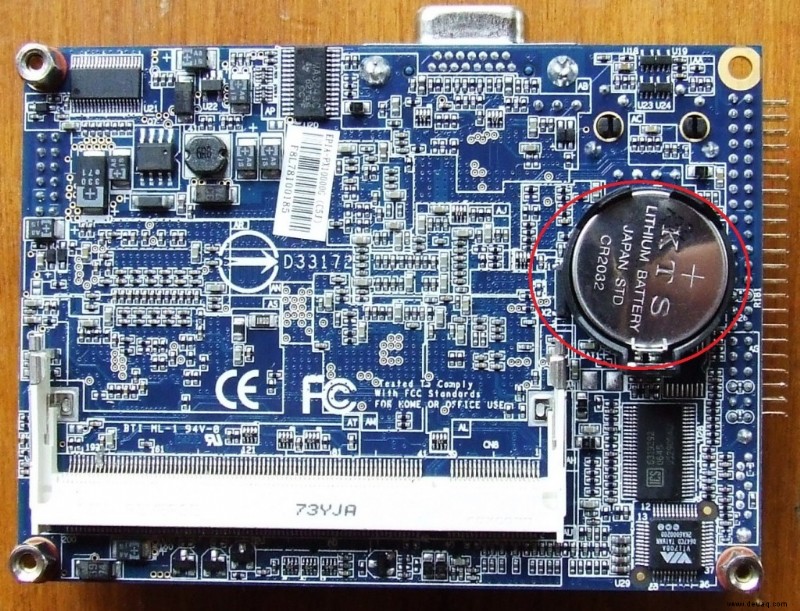
Finally, there are two more quick tests you can perform. The first and quickest is to reset the board’s CMOS by removing the battery. The second is to test the components outside the PC case. We have a great step-by-step guide over on the PCMech Forums that will take you through these steps to determine if you have a short or faulty component.
It’s Dead – Now What?
Unfortunately, if going through the diagnostic procedures above did not help, it may be time for a new motherboard. There’s no real way to tell how your motherboard died. Electronic parts experience wear and tear like anything else.
All parts do eventually die; it’s a normal thing, though sometimes motherboards can die from being shorted out by a low-quality power supply. Again, this is something you can determine by putting a new and hopefully higher quality power supply in your machine and seeing if it runs or not.
If you know your motherboard is dead, as an alternate route, you could try and repair your motherboard, but it’s no easy task. You would need a solid understanding of electrical components, such as capacitors, for instance. You’d need to not only understand the risk of electrical shock, but also that it’s difficult to check if a capacitor is dead on modern motherboards. However, if you want to give it a go, Tom’s Hardware has put together an excellent and well-researched guide on replacing capacitors.
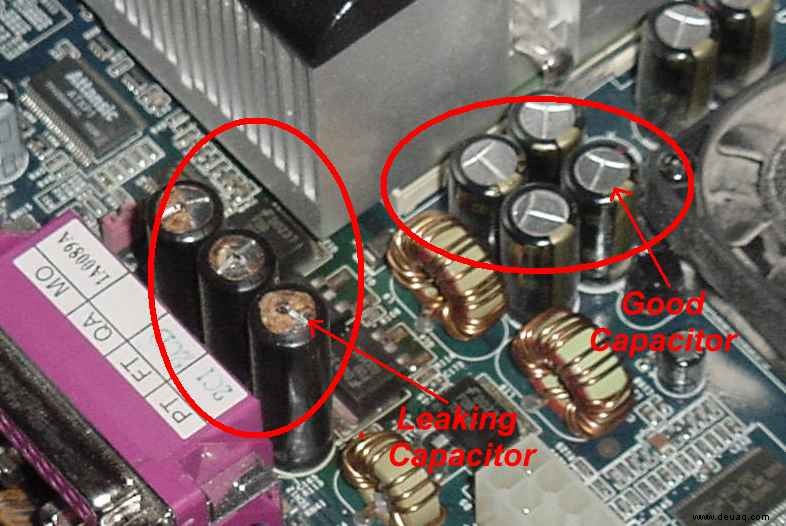
For most people, though, they’re much better off buying a new motherboard. In this case, it’s best to look for an exact replacement. If it’s too old, you might want to consider looking into a newer motherboard for your system as long as your components will work with it. On the other hand, it might be worth looking into building an all-new PC if you can afford it.
It’s worth heading on over to the PCMech forums and consulting some of our experts on what board is best to buy for your system. Alternatively, you could get some good advice on building a new PC, if that’s the route you decide to take!
Data Recovery
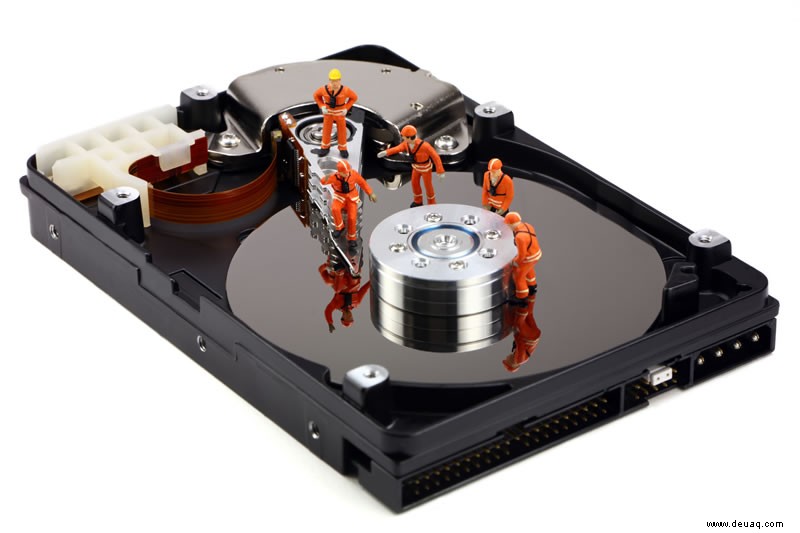
As far as data recovery goes with a dead motherboard, you’ve truly lucked out. If it was a dead hard drive, chances are, you’d have to send your hard drive to a data recovery service who would then charge you hundreds or even thousands of dollars to recover your data. And that’s if your data was even recoverable.
Recovering your data is as simple as getting a new motherboard and putting the computer back together. However, with your old hard drive plugged in, you’ll need to select it as the boot device in the BIOS settings first. After that, all of your data should still be there on bootup.
Alternatively, all you need is an adapter that turns your hard drive into an external hard drive. At that point, you can just plug it into another computer and all of your data should be available.